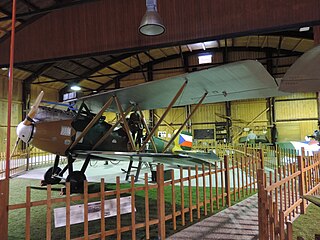The Albatros L 58 was a German airliner of the 1920s. It was a single-engine cantilever monoplane which accommodated the pilot in an open cockpit at the top of the fuselage, and seated five-six passengers within it.

The Maybach Mb IVa was a water-cooled aircraft and airship straight-six engine developed in Germany during World War I by Maybach-Motorenbau GmbH, a subsidiary of Zeppelin. It was one of the world's first series-produced engines designed specifically for high-altitude use. It was quite different engine design than the previous Maybach Mb.IV, not just a simple modification.

The Letov Š-1 was a Czechoslovak single-engined, two-seat biplane surveillance aircraft. It was the first military aircraft built in Czechoslovakia. It was designed by Alois Šmolík at Letov Kbely. The Š-1 first flew in 1920.

Hansa-Brandenburg W.33 was a German two-seat, single-engined low-wing monoplane floatplane, which had been developed by Hansa und Brandenburgische Flugzeugwerke during World War I as a higher powered enlargement of the similar Hansa-Brandenburg W.29 and despite the increase in size the two types are very difficult to differentiate. Although the W.33 was built in small numbers during the war many license built versions were built after World War I.

The Hansa-Brandenburg W.19 was a German fighter-reconnaissance aircraft of World War I. It was a single-engined two-seat biplane floatplane, and was a larger development of the successful W.12. It served with the Kaiserliche Marine during 1918.

The Gotha WD.7 was a reconnaissance floatplane developed in the German Empire during World War I.

The Heinkel HE 8 was a reconnaissance floatplane built in Germany in the late 1920s. It was developed at the request of the Danish Navy, which had noted the success of the HE 5 in Swedish service, and wished to purchase a similar aircraft as well as licensed production as the Orlogsvaerftet HM.II. Apart from its new Armstrong Siddeley engine, the HE 8 also differed from the HE 5 and previous members of the HE 1 family in having a conventional empennage. 22 aircraft were operated until the German invasion in 1940, after which one example was impressed into Luftwaffe service and the remainder placed in storage.

The Sablatnig P.III was an airliner produced in Germany in the early 1920s.
The Zeppelin-Staaken R.XV was an Imperial German bomber of World War I. An incremental improvement to the Zeppelin-Staaken R.VI, this was one of a series of large strategic bombers called Riesenflugzeuge, intended to be less vulnerable than dirigibles in use at the time.

The Zeppelin-Staaken R.XIV was a development of the Zeppelin-Staaken R.VI. This was one of a series of large bombers called Riesenflugzeuge, intended to be less vulnerable than the dirigibles in use at the time.
The Kawanishi K-7 Transport Seaplane was a Japanese single-engined biplane floatplane of the 1920s. Eleven were built from 1924 to 1927, being used to carry passengers and airmail.

The Fizir F1V was the basis from which engineer Rudolf Fizir developed a series of single-engined, two-seat, reconnaissance biplanes fitted with different engines. Construction was carried out in the Yugoslav aircraft factories Zmaj and Rogožarski between 1928 and 1932.

The Kawanishi K-8 Transport Seaplane was a Japanese single-engined floatplane of the 1920s. Seven were built in 1926 and 1927, and were used to operate airmail services.

The Rumpler C.X, produced under the company designation Rumpler 8C 14, was a German two-seat observation aircraft. It was developed from the earlier Rumpler 8C 13 prototype by Rumpler in early 1918. The prototype had a similar wing design to the Rumpler C.VII, powered by a 260 hp (194 kW) Mercedes D.IVa engine and was later powered by a 240 hp (179 kW) Maybach Mb.IVa. The C.X had the highest top speed and service ceiling of all German C-type aircraft and an order was placed for the aircraft in August 1918, but few were built and tested before the war ended.

LZ 120 Bodensee was a passenger-carrying airship built by Zeppelin Luftschiffbau in 1919 to operate a passenger service between Berlin and Friedrichshafen. It was later handed over to the Italian Navy as war reparations in place of airships that had been sabotaged by their crews and renamed Esperia. A sister-ship, LZ 121 Nordstern, was built in 1920: it was handed over to France and renamed Méditerranée.

The Sablatnig C.III was a monoplane C-type reconnaissance two-seater aircraft developed and built by Sablatnig in Berlin, Germany, in 1918.
The Polikarpov PM-1 was a passenger aircraft created by Polikarpov in the 1920s.
The Caspar CLE 12 was an airliner built in Germany in the early 1920s.
The Kawanishi K-10 Transport was a 1920s Japanese passenger and mail transport. Two were built, one briefly serving a route between cities in Japan, Korea and China.
The Kawanishi K-3 was a Japanese, fast, multi-purpose civil transport aircraft from the early 1920s. Despite its good performance it was eclipsed by the release of Army surplus machines and only one was built.













